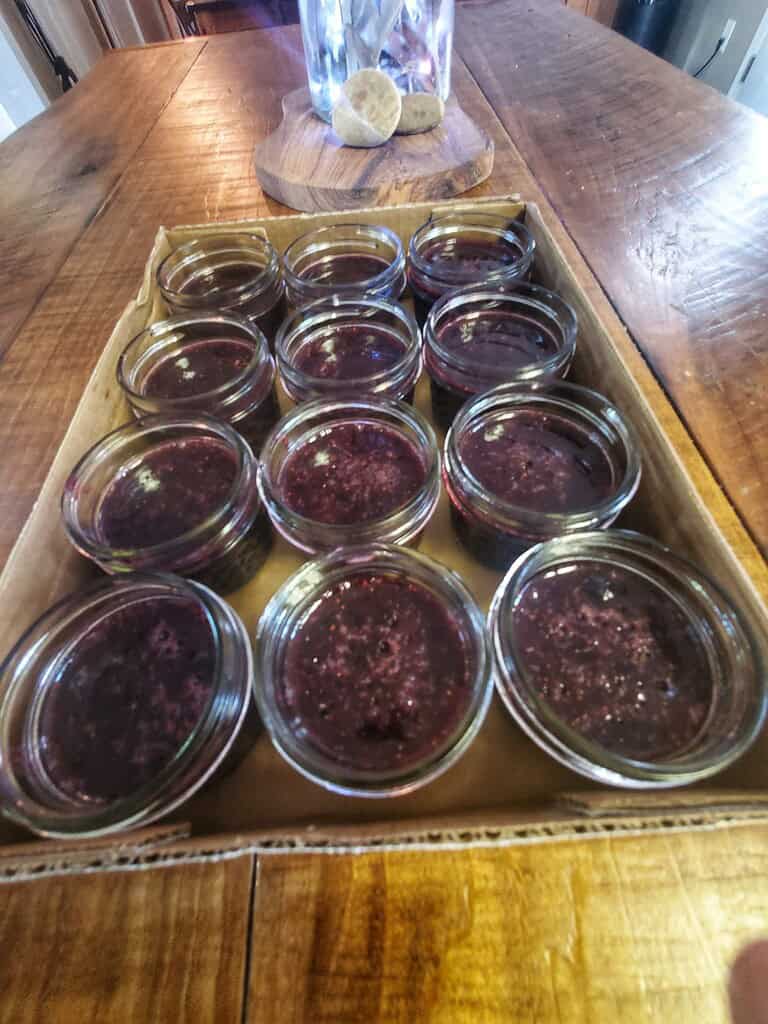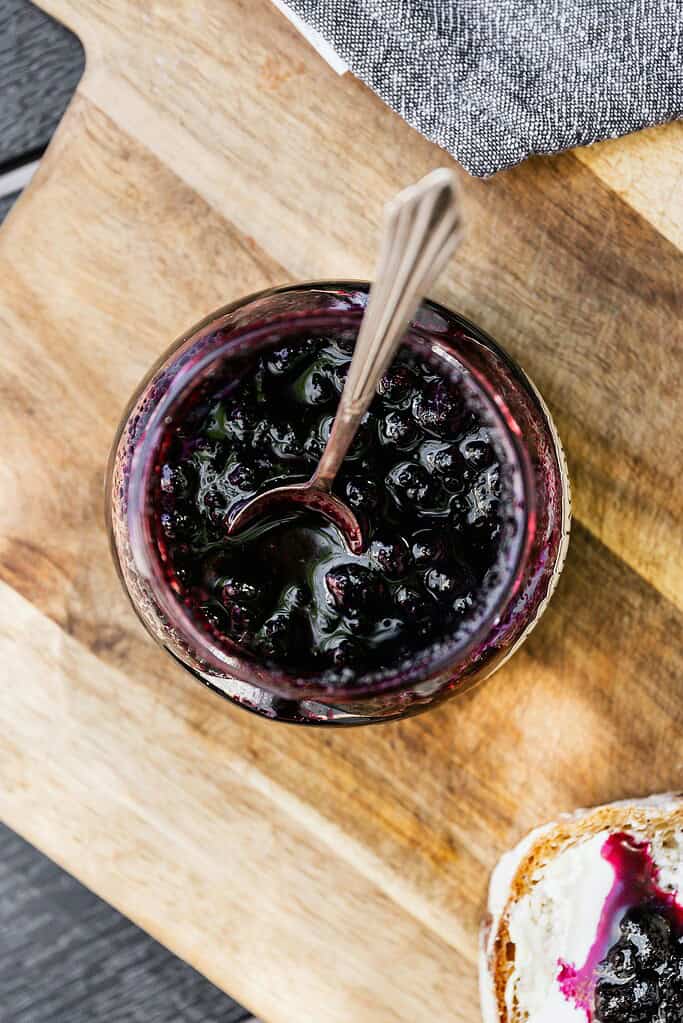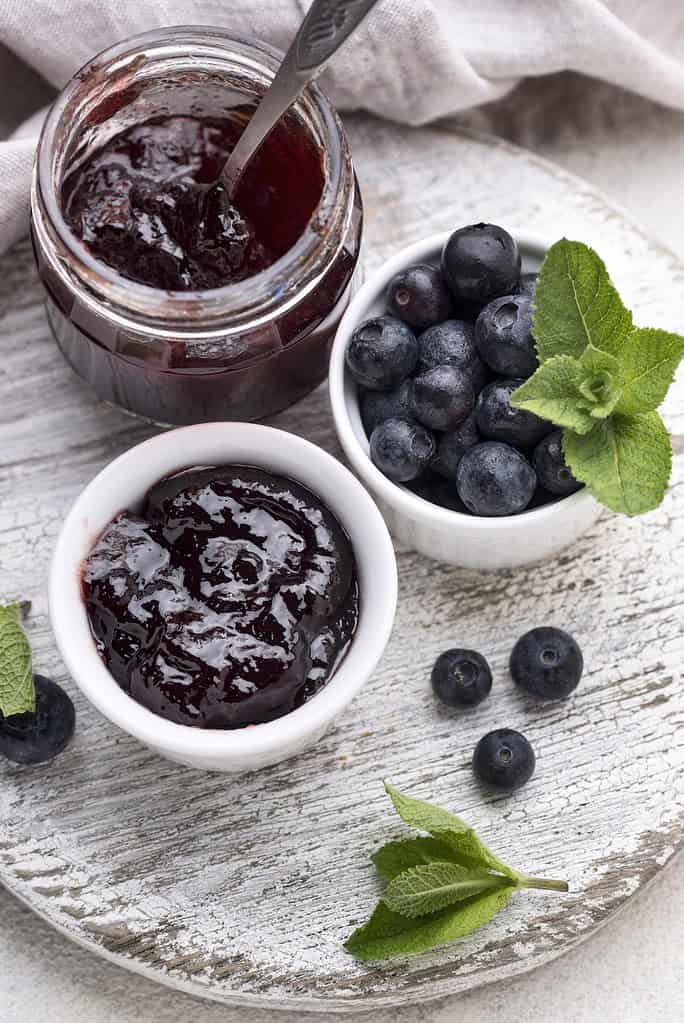Blueberry jam is one of those simple homemade treats that always feels special.
With just a few ingredients and a little time at the stove, you can create a jar of sweet, tangy jam that captures the flavor of fresh blueberries.
This small-batch version is designed to be enjoyed right away – perfect for spreading on warm toast, spooning over yogurt, or drizzling onto pancakes.
Because it’s made in a small amount, you don’t need special canning equipment or long cooking times, and you’ll have just enough to enjoy while it’s fresh.
Whether you’re using blueberries picked straight from the garden or a bag of frozen berries, this recipe is an easy way to enjoy the season’s flavor any time of year.
Why Make Small-Batch Blueberry Jam

Small-batch jam has a lot of advantages. You don’t need any special canning gear, and the whole process is faster and easier to manage.
If you only have a few cups of berries from the garden or farmers market, this recipe is a great way to use them without committing to a big preserving project. (And if you want to grow your own supply, here’s a simple guide on how to grow blueberries.)
Because it’s made in a small amount, you can enjoy the jam at its freshest and brightest flavor.
There’s no pressure to store jars for months, and you can easily experiment with flavors (like adding a touch of spice or combining fruits) without worrying about wasting ingredients.
It’s also a good entry point for anyone new to making jam. With a small batch, it’s easy to stir, monitor, and adjust, making the process approachable even if you’ve never tried it before.
Looking for more ways to fill your pantry? This recipe is included in our Jam Series. Take a peek at the others here.
What You’ll Need
This recipe keeps things simple – you only need a few basic ingredients to make a small jar of jam that tastes fresh and vibrant.
- 4 cups fresh or frozen blueberries
- 1 cup granulated sugar
- 1 tablespoon bottled lemon juice
- Optional: 1 pinch ground cinnamon
How to Make Blueberry Jam (Step-by-Step Instructions)

This recipe is a refrigerator or freezer jam, meaning it is not shelf-stable unless you use a tested canning recipe. Follow these steps carefully for safe, reliable results:
1. Prepare the Ingredients
Wash blueberries thoroughly under cool running water. Remove stems, leaves, and any soft or shriveled fruit. Measure out the sugar and bottled lemon juice so everything is ready to go.
2. Cook the Jam
Place the blueberries, sugar, lemon juice, and optional cinnamon into a medium, heavy-bottomed saucepan. Set the heat to medium and stir often as the berries begin to soften and release juice.
As the mixture simmers, mash some of the berries with a potato masher or the back of a spoon.
Continue to cook, stirring frequently to prevent sticking, until the jam thickens and coats the back of a spoon – about 20 to 30 minutes.
3. Test the Thickness
Remove a spoonful of jam and let it cool for a minute. If it slides slowly off the spoon instead of dripping like juice, it’s ready. If not, continue cooking a few minutes longer and test again.
4. Cool and Store Safely
Take the pan off the heat and let the jam cool for 10–15 minutes. Transfer to clean glass jars or freezer-safe containers, leaving about ½ inch of headspace if freezing.
Allow to cool to room temperature before sealing.
Refrigerate and use within 2–3 weeks, or freeze for up to 6 months.
Note: This recipe is not designed for canning. If you want a shelf-stable blueberry jam, you’ll need to follow a tested recipe that uses the proper sugar, acid, and fruit ratios.
How to Store Homemade Blueberry Jam

Once your jam is cooked, proper storage is the key to keeping it fresh and safe to enjoy:
- Check before eating – Always look for signs of spoilage before using. Discard if you notice mold, bubbling, off odors, or unusual changes in color or texture.
- Cool before storing – Let the jam cool to room temperature before sealing jars or containers. This prevents condensation and helps maintain the right texture.
- Refrigerator storage – Keep in a clean, airtight glass jar or food-safe container. Store in the refrigerator and use within 2–3 weeks for best quality.
- Freezer storage – For longer storage, portion the cooled jam into freezer-safe containers, leaving about ½ inch of headspace at the top. Freeze for up to 6 months. Thaw in the refrigerator before use.
- Not shelf-stable – This small-batch recipe is not designed for water bath canning or long-term pantry storage. If you want jam that can be stored at room temperature, use a tested, shelf-stable recipe made specifically for canning.
Variations and Texture Adjustments for Blueberry Jam

One of the best things about small-batch jam is the flexibility to make it just the way you like.
Here are safe ways to adjust the flavor and texture without affecting freshness or storage:
- Chunky jam – Use a potato masher during cooking to break down some berries while leaving others whole for a rustic, spoonable texture.
- Smooth jam – After cooking, use an immersion blender directly in the pot (carefully, while still warm) until the mixture reaches your preferred consistency.
- Thicker jam – Continue simmering a little longer to let more liquid evaporate. Stir often to prevent sticking. You can also use a small amount of commercial fruit pectin if you prefer a firmer set.
- Flavor variations – Add a pinch of warm spices (like cinnamon or nutmeg), or stir in a splash of vanilla extract after cooking for extra depth of flavor.
Avoid thickeners like cornstarch or flour. They are not recommended for jams, as they can cause cloudiness, separation, or spoilage.
Stick to safe methods such as extended cooking or using pectin.
5 Tips for Making the Best Blueberry Jam

A small batch of jam is simple to make, but a few smart habits can help you get the best results every time:
- Taste as you go – Blueberries can vary in sweetness. If yours are especially tart, add a bit more sugar near the end of cooking.
- Keep the heat steady – Medium heat allows the jam to thicken evenly. High heat can scorch the sugar before the berries are ready.
- Don’t skip the lemon juice – It balances flavor and ensures the right acidity level to help the jam set properly.
- Stir often – This prevents sticking and burning, especially as the jam thickens.
- Check the texture after cooling – Jam firms up as it cools, so let it rest before deciding whether it’s thick enough.
With these simple practices, your blueberry jam will be flavorful, smooth, and reliably spreadable.
Common Mistakes to Avoid
Even though blueberry jam is simple, a few common missteps can affect the flavor, texture, or safety. Keep these in mind so every batch turns out well:
- Overcooking the jam – Cooking too long can make the jam overly thick, sticky, or even give it a burnt taste.
- Forgetting to stir – Jam scorches quickly if left unattended. Stir regularly, especially as it thickens.
- Reducing sugar too much – Sugar helps the jam set and keeps it stable in the fridge. Cutting it back significantly can result in a runny texture and faster spoilage.
- Skipping the lemon juice – The acidity is essential for proper setting and balanced flavor.
- Improper storage – Leaving jam out at room temperature, or storing it in unclean containers, can shorten its shelf life and increase spoilage risk.
- Trying to can this recipe – This small-batch jam is not tested for water bath canning. If you want shelf-stable jam, choose a tested recipe designed specifically for safe canning.
By steering clear of these mistakes, you’ll keep your jam both delicious and safe to enjoy.
Make Your Own Blueberry Jam Today
With just a handful of ingredients and less than an hour in the kitchen, you can create fresh blueberry jam that’s brighter and more flavorful than anything from the store.
This small-batch recipe is easy, flexible, and perfect for enjoying on toast, stirred into yogurt, or as a sweet topping for desserts.
Make a batch when blueberries are in season, or keep frozen berries on hand so you can whip up a jar any time of year.
Try it once, and you’ll see just how easy homemade jam can be.
FAQs
Can I use frozen blueberries to make jam?
Yes! Frozen blueberries work just as well as fresh. There’s no need to thaw them before cooking—just add a few extra minutes to the cooking time as they release more liquid.
How long does homemade blueberry jam last?
This small-batch jam should be stored in the refrigerator and used within 2–3 weeks. For longer storage, freeze in airtight, freezer-safe containers for up to 6 months. Thaw in the refrigerator before serving.
Can I reduce the sugar in this recipe?
Sugar is important for texture, flavor, and stability in refrigerator jams. While you may reduce it slightly, keep in mind the jam will be softer and may spoil faster. For a truly lower-sugar option, it’s best to use a tested low-sugar pectin recipe.
Is this blueberry jam safe for canning?
No. This recipe is not tested for water bath canning and should not be stored at room temperature. If you want a shelf-stable blueberry jam, use a tested canning recipe designed with the proper balance of fruit, sugar, and acid.
How do I know when the jam is done cooking?
Jam is ready when it thickens enough to coat the back of a spoon and slides off slowly rather than dripping like juice. You can also place a small spoonful on a cold plate – if it wrinkles slightly when pushed, it’s done.
